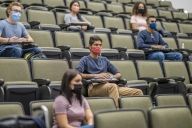You have /5 articles left.
Sign up for a free account or log in.
Some truce.
Try as they might to stick to the stated goal of having Thursday's hearing of the U.S. House Government Reform Committee focus not on the relative merits of the government's two student loan programs but on the programs' performance, lawmakers and the witnesses they had strategically invited just couldn't do it.
Yes, they acknowledged repeatedly that the competition between the traditional lender-based loan program and the federal government's direct-loan program has improved both programs and benefited students, colleges and taxpayers. In addition -- and this represents progress in the decade-plus war over the more-than-$50-billion market in federal student loans -- all parties generally agreed that the government should sustain both programs to give colleges a choice and stoke that competition.
For instance, Rep. Mark Souder (R-Ind.), a member both of the government reform committee and of the House Committee on Education and the Workforce, which is preparing to renew the Higher Education Act that governs federal student aid programs, said that that panel's leaders "have declared a working truce" between "those of us who believe direct lending ought to be eliminated and those who believe the private sector ought to be eliminated."
But like just about everyone else who spoke at Thursday's hearing, Souder went on to take a side and badmouth one of the programs. In Souder's case, he said the Education Department had provided "deceitful numbers" to federal budgeters and accountants to try to show that the direct lending program costs the government significantly less to manage than the Family Federal Education Loan Program does. He also argued that institutions are abandoning the government program at an "increasing rate."
Democratic supporters of the direct lending program, in which colleges provide loan funds directly to students without the involvement of banks or other lenders, engaged in mirror image rhetoric. Rep. Henry Waxman (D-Cal.) followed his statement that he is "not opposed to the guaranteed loan program" by saying that "it doesn't make sense that the guaranteed loan program should cost the taxpayers so much more than the government loan program." Rep. Eleanor Holmes Norton (D-D.C.) bemoaned as "simply indefensible" the subsidies that the government pays to the banks and guarantee agencies, which President Bush and the House education panel have proposed cutting back.
The college officials whom the committee had invited to testify at the hearing all told the committee that the competition between the two programs had been a boon to their institutions and their students, and that both should be not only continued but strengthened. The two programs "working together have resulted in the most effective and efficient improvements in the financial aid system," said Natala K. Hart, director of student financial aid at Ohio State University. "While we remain steadfastly a [direct lending] school, we encourage continuation of FFELP as well as DL, as competition makes both programs more receptive to students' needs."
Of the five higher education witnesses, three were from institutions (Dillard University, George Mason University and the University of Maryland at College Park) in the guaranteed loan program and a fourth, Nancy Coolidge, represented the University of California system, which has six direct lending campuses and four in the guaranteed program. Predictably, all said good things about their chosen program, though with varying degrees of partisanship.
George Mason and Dillard were among the institutions that had switched to the direct lending program in its early stages, only to switch back. Alan Merten, George Mason's president, said the university had returned to the guaranteed program last year because "the competition among private lenders has provided savings and other benefits to parents and students that direct lending cannot match."
Cynthia Thornton, director of financial aid at Dillard, raved about the benefits Sallie Mae and the other lenders the university works with provide to its students, and strongly discouraged lawmakers from considering enacting the Student Aid Rewards Act (H.R. 1425 and S. 754). That legislation aims to bolster the direct loan program by cutting subsidies for lenders in the guaranteed program to offer additional financial aid for low-income students to colleges that switch to the government program, and Republican lawmakers have accused Democrats of trying to wipe out the guaranteed loan program.
Coolidge of the University of California, meanwhile, argued that while the two loan programs are now competing, the competition is unfolding on a playing field that favors the guaranteed program. "Because of federal subsidies to lenders and guarantors," she argued, "FFEL borrowers can currently get less costly loans along with state-of-the-art service" from the lending industry. The government also allows colleges in the guaranteed loan program to share in the profits by loaning money themselves to graduate and professional students, an option that is not permitted in the direct loan program, Coolidge noted.
"This imbalance favors the FFEL program and threatens to undermine the utility of the direct loan program to inspire the sort of reform and innovation that the FFEL program produced in response to the advent of the direct loan program" a decade ago," she said.
The chairman of the Government Reform Committee, Rep. Tom Davis (R-Va.), said he hoped that the Government Accountability Office would shed new light on the relative costs and benefits of the two loan programs in a report, commissioned by Congress, that is due in September. He suggested that the GAO study "Until we get that GAO report, we just don't know the costs," he said.
Amid the positioning and lobbying, there was some discussion of Davis's actual stated purpose for the hearing: assessing the "management and performance of both loan programs." The head of the Education Department's federal student assistance office, Theresa S. Shaw, and the department's inspector general, John P. Higgins Jr., both noted that the student loan programs had recently come off the federal government's "watch" list of programs at high risk for fraud and abuse.









